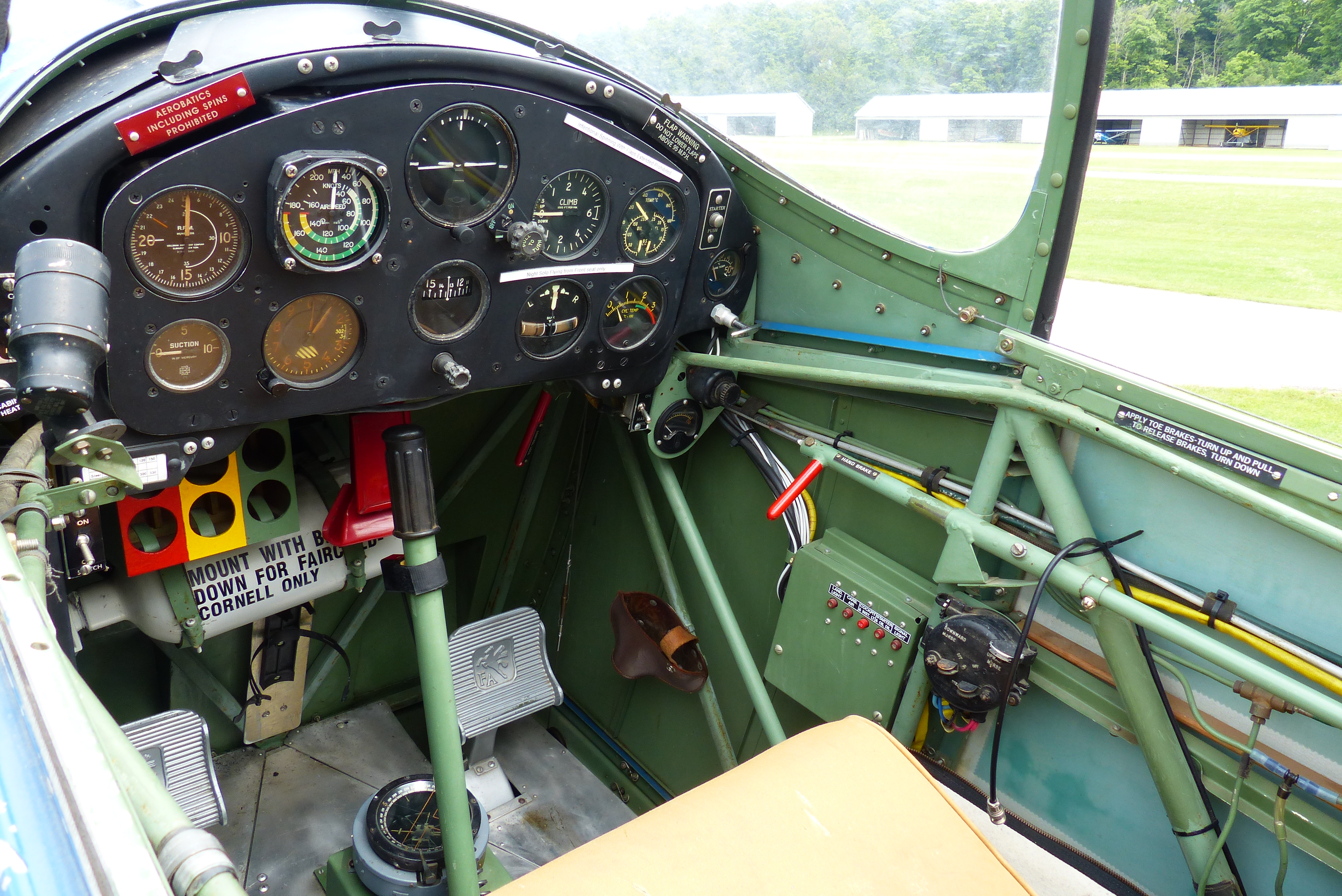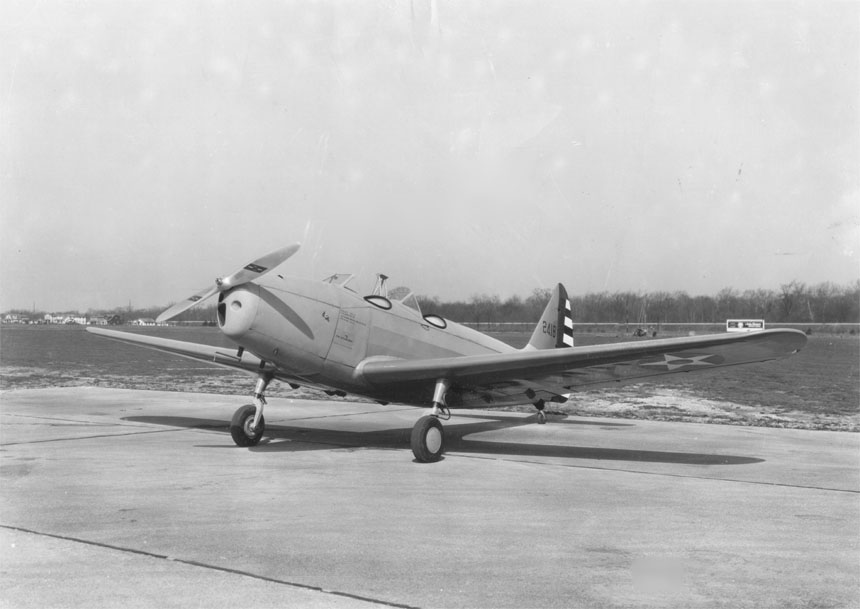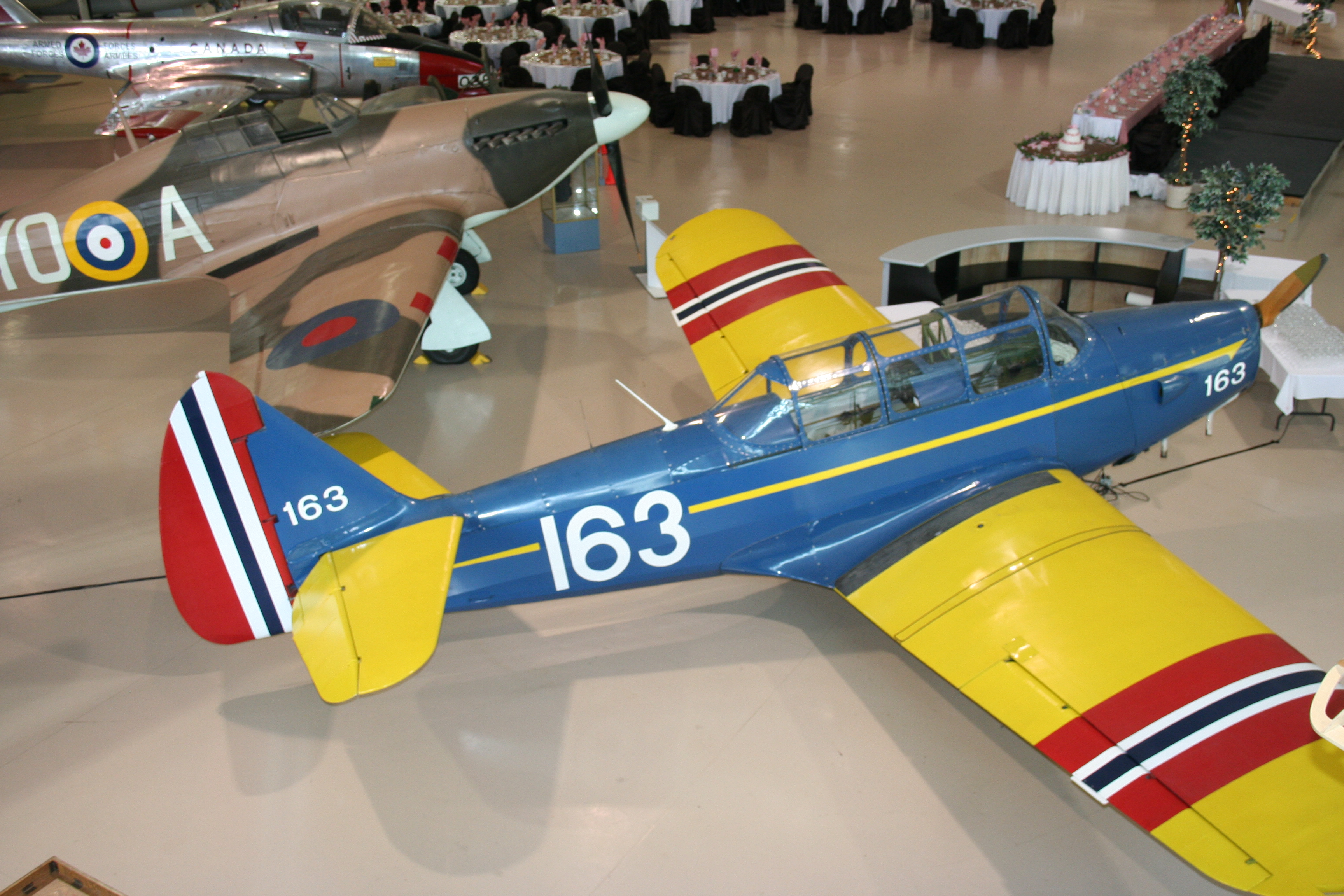PT-26 Cornell on:
[Wikipedia]
[Google]
[Amazon]
The Fairchild PT-19 (company designation Fairchild M62) is an American monoplane primary trainer aircraft that served with the United States Army Air Forces, RAF and RCAF during World War II. Designed by





 The M-62 first flew in May 1939 and won a fly-off competition later that year against 17 other designs for the new Army training airplane. Fairchild was awarded its first Army PT contract for an initial order on 22 September 1939.
The original production batch of 275 were powered by the inline 175 hp Ranger L-440-1 engine and designated the PT-19. In 1941, mass production began and 3,181 of the PT-19A model, powered by the 200 hp L-440-3, were made by Fairchild. An additional 477 were built by
The M-62 first flew in May 1939 and won a fly-off competition later that year against 17 other designs for the new Army training airplane. Fairchild was awarded its first Army PT contract for an initial order on 22 September 1939.
The original production batch of 275 were powered by the inline 175 hp Ranger L-440-1 engine and designated the PT-19. In 1941, mass production began and 3,181 of the PT-19A model, powered by the 200 hp L-440-3, were made by Fairchild. An additional 477 were built by
''Design and Engineering Problems of Aircraft Production''.
14 May 1946, pp. 6–8. Subsequent to this incident, the USAAF incorporated a demand for all-metal wing sections on all future fixed-wing training aircraft. The final variant was the PT-26 which used the L-440-7 engine. The Canadian-built versions of these were designated the Cornell for use by the
 Compared to the earlier
Compared to the earlier


 ;PT-19
:Initial production variant of the Model M62 powered by 175 hp L-440-1, 270 built.
;PT-19A
:As the PT-19 but powered by a 200 hp L-440-3 and detailed changes, redesignated T-19A in 1948, 3226 built.
;PT-19B
:Instrument training version of the PT-19A, 143 built and six conversions from PT-19A.
;XPT-23A
:A PT-19 re-engined with a 220 hp R-670-5 radial engine.
;PT-23
:Production radial-engined version, 774 built.
;PT-23A
:Instrument training version of the PT-23, 256 built.
;PT-26
:PT-19A variant with enclosed cockpit for the Commonwealth Air Training Scheme, powered by a 200hp L-440-3, 670 built for the Royal Canadian Air Force as the Cornell I.
;PT-26A
:As PT-26 but with a 200hp L-440-7 engine, 807 built by Fleet as the Cornell II.
;PT-26B
:AS PT-26A with minor changes, 250 built as the Cornell III.
;Cornell I
:RCAF designation for the PT-26.
;Cornell II
:RCAF designation for the PT-26A.
;Cornell III
:RCAF designation for the PT-26B.
;PT-19
:Initial production variant of the Model M62 powered by 175 hp L-440-1, 270 built.
;PT-19A
:As the PT-19 but powered by a 200 hp L-440-3 and detailed changes, redesignated T-19A in 1948, 3226 built.
;PT-19B
:Instrument training version of the PT-19A, 143 built and six conversions from PT-19A.
;XPT-23A
:A PT-19 re-engined with a 220 hp R-670-5 radial engine.
;PT-23
:Production radial-engined version, 774 built.
;PT-23A
:Instrument training version of the PT-23, 256 built.
;PT-26
:PT-19A variant with enclosed cockpit for the Commonwealth Air Training Scheme, powered by a 200hp L-440-3, 670 built for the Royal Canadian Air Force as the Cornell I.
;PT-26A
:As PT-26 but with a 200hp L-440-7 engine, 807 built by Fleet as the Cornell II.
;PT-26B
:AS PT-26A with minor changes, 250 built as the Cornell III.
;Cornell I
:RCAF designation for the PT-26.
;Cornell II
:RCAF designation for the PT-26A.
;Cornell III
:RCAF designation for the PT-26B.
 ;
*
;
*  ;
;
* Colombian Air ForceBridgman 1948, p. 10a.
;
* Ecuadorian Air ForceBridgman 1951, p. 7a.
;Bridgman 1951, p. 17a.
;
* Guatemalan Air Force
;
*
;
;
* Colombian Air ForceBridgman 1948, p. 10a.
;
* Ecuadorian Air ForceBridgman 1951, p. 7a.
;Bridgman 1951, p. 17a.
;
* Guatemalan Air Force
;
*

"The World's Air Forces"
'' Flight''. Vol. 67, No. 2416, 13 May 1955. pp. 615–668.
Cavanaugh Flight Museum PT-19
Golden Wings Flying Museum Fairchild PT-19A
{{DEFAULTSORT:Fairchild Pt-19 Low-wing aircraft Single-engined tractor aircraft 1930s United States military trainer aircraft World War II trainer aircraft of the United States PT-19 Aircraft first flown in 1939
Fairchild Aircraft
Fairchild was an American aircraft and aerospace manufacturing company based at various times in Farmingdale, New York; Hagerstown, Maryland; and San Antonio, Texas.
History
Early aircraft
The company was founded by Sherman Fairchild in 1 ...
, it was a contemporary of the Kaydet biplane
A biplane is a fixed-wing aircraft with two main wings stacked one above the other. The first powered, controlled aeroplane to fly, the Wright Flyer, used a biplane wing arrangement, as did many aircraft in the early years of aviation. While ...
trainer, and was used by the USAAF during Primary Flying Training. As with other USAAF trainers of the period, the PT-19 had multiple designations based on the powerplant installed.
Design and development
The PT-19 series was developed from the Fairchild M-62 when the USAAC first ordered the aircraft in 1940 as part of its expansion program. The cantilever low-wing monoplane with fixed landing gear and tailwheel design was based on a two-place, tandem-seat, opencockpit
A cockpit or flight deck is the area, usually near the front of an aircraft or spacecraft, from which a Pilot in command, pilot controls the aircraft.
The cockpit of an aircraft contains flight instruments on an instrument panel, and the ...
arrangement. The simple but rugged construction included a fabric-covered welded steel tube fuselage. The remainder of the aircraft used plywood construction, with a plywood-sheathed center section, outer wing panels and tail assembly
The empennage ( or ), also known as the tail or tail assembly, is a structure at the rear of an aircraft that provides stability during flight, in a way similar to the feathers on an arrow.Crane, Dale: ''Dictionary of Aeronautical Terms, third e ...
. The use of an inline engine allowed for a narrow frontal area which was ideal for visibility while the widely set-apart fixed landing gear allowed for solid and stable ground handling.



Aeronca
Aeronca, contracted from Aeronautical Corporation of America, located in Middletown, Ohio, is a US manufacturer of engine components and airframe structures for commercial aviation and the defense industry, and a former aircraft manufacturer. Fr ...
and 44 by the St. Louis Aircraft Corporation. The PT-19B, of which 917 were built, was equipped for instrument flight training by attaching a collapsible hood to the front cockpit.
When a shortage of engines threatened production, the PT-23 model was introduced which was identical except for the 220 hp Continental R-670 radial powerplant. A total of 869 PT-23s were built as well as 256 of the PT-23A, which was the instrument flight-equipped version. The PT-23 was manufactured in the US by Fairchild, Aeronca, St. Louis Aircraft Corporation
St. Louis Aircraft Corporation was an American aircraft manufacturer founded in September 1917.
In 1915, the St. Louis Car Company had been approached by Thomas W. Benoist to build 1000 flying boats. A prototype was built, but the concept did n ...
and Howard Aircraft Corporation and in Canada by Fleet Aircraft Corporation as well as Fabrica do Galeao in Brazil (220 or 232 between 1944 and 1948).
During 1943, USAAF Training Command received a number of complaints about durability issues with the plywood wings of the PT-19 and the PT-23 when exposed to the high heat and/or humidity of training bases located in Texas and Florida. Maintenance officers at the USAAF overhaul depots had been forced to order replacement of the wooden wing sections after only two to three months' active service because of wood rot and ply separation issues.Sessums, Col. J.W''Design and Engineering Problems of Aircraft Production''.
14 May 1946, pp. 6–8. Subsequent to this incident, the USAAF incorporated a demand for all-metal wing sections on all future fixed-wing training aircraft. The final variant was the PT-26 which used the L-440-7 engine. The Canadian-built versions of these were designated the Cornell for use by the
British Commonwealth Air Training Plan
The British Commonwealth Air Training Plan (BCATP), or Empire Air Training Scheme (EATS) often referred to as simply "The Plan", was a massive, joint military aircrew training program created by the United Kingdom, Canada, Australia and New Zea ...
which was centered in Canada.
Operational history
 Compared to the earlier
Compared to the earlier biplane
A biplane is a fixed-wing aircraft with two main wings stacked one above the other. The first powered, controlled aeroplane to fly, the Wright Flyer, used a biplane wing arrangement, as did many aircraft in the early years of aviation. While ...
trainers, the Fairchild PT-19 provided a more advanced type of aircraft. Speeds were higher and wing loading more closely approximated that of combat aircraft, with flight characteristics demanding more precision and care. Its virtues were that it was inexpensive, simple to maintain and, most of all, virtually viceless. The PT-19 truly lived up to its nickname, the Cradle of Heroes. It was one of a handful of primary trainer designs that were the first stop on a cadet's way to becoming a combat pilot.
These planes were delivered to various bases all over the country by WASPs (Women's Airforce Service Pilots) between 1942-1944.
Thousands of the PT-19 series were rapidly integrated into the United States and Commonwealth training programs, serving throughout World War II and beyond. Even after their retirement in the late 1940s, a substantial number found their way onto the United States and other civil registers, being flown by private pilot owners.
Variants


 ;PT-19
:Initial production variant of the Model M62 powered by 175 hp L-440-1, 270 built.
;PT-19A
:As the PT-19 but powered by a 200 hp L-440-3 and detailed changes, redesignated T-19A in 1948, 3226 built.
;PT-19B
:Instrument training version of the PT-19A, 143 built and six conversions from PT-19A.
;XPT-23A
:A PT-19 re-engined with a 220 hp R-670-5 radial engine.
;PT-23
:Production radial-engined version, 774 built.
;PT-23A
:Instrument training version of the PT-23, 256 built.
;PT-26
:PT-19A variant with enclosed cockpit for the Commonwealth Air Training Scheme, powered by a 200hp L-440-3, 670 built for the Royal Canadian Air Force as the Cornell I.
;PT-26A
:As PT-26 but with a 200hp L-440-7 engine, 807 built by Fleet as the Cornell II.
;PT-26B
:AS PT-26A with minor changes, 250 built as the Cornell III.
;Cornell I
:RCAF designation for the PT-26.
;Cornell II
:RCAF designation for the PT-26A.
;Cornell III
:RCAF designation for the PT-26B.
;PT-19
:Initial production variant of the Model M62 powered by 175 hp L-440-1, 270 built.
;PT-19A
:As the PT-19 but powered by a 200 hp L-440-3 and detailed changes, redesignated T-19A in 1948, 3226 built.
;PT-19B
:Instrument training version of the PT-19A, 143 built and six conversions from PT-19A.
;XPT-23A
:A PT-19 re-engined with a 220 hp R-670-5 radial engine.
;PT-23
:Production radial-engined version, 774 built.
;PT-23A
:Instrument training version of the PT-23, 256 built.
;PT-26
:PT-19A variant with enclosed cockpit for the Commonwealth Air Training Scheme, powered by a 200hp L-440-3, 670 built for the Royal Canadian Air Force as the Cornell I.
;PT-26A
:As PT-26 but with a 200hp L-440-7 engine, 807 built by Fleet as the Cornell II.
;PT-26B
:AS PT-26A with minor changes, 250 built as the Cornell III.
;Cornell I
:RCAF designation for the PT-26.
;Cornell II
:RCAF designation for the PT-26A.
;Cornell III
:RCAF designation for the PT-26B.
Operators
 ;
*
;
* Brazilian Air Force
"Wings that protect the country"
, colours =
, colours_label =
, march = Hino dos Aviadores
, mascot =
, anniversaries = 22 May (anniver ...
Andrade 1979, p. 179
;
* Royal Canadian Air ForceAndrade 1979, p. 239
;
* Chilean Air ForceBridgman 1951, p. 6a.
 ;
;
* Colombian Air ForceBridgman 1948, p. 10a.
;
* Ecuadorian Air ForceBridgman 1951, p. 7a.
;Bridgman 1951, p. 17a.
;
* Guatemalan Air Force
;
*
;
;
* Colombian Air ForceBridgman 1948, p. 10a.
;
* Ecuadorian Air ForceBridgman 1951, p. 7a.
;Bridgman 1951, p. 17a.
;
* Guatemalan Air Force
;
*Haiti Air Corps
The Haiti Air Corps (french: Corps d'Aviation d'Haiti (Corps d’Aviation de 1’Armee d’Haiti)) was the air force of Haiti from 1942 to 1994. The air corps was disbanded along with the rest of the armed forces after Operation Uphold Democracy, t ...
''Flight'' 13 May 1955, p. 634.
;
* Honduran Air Force - PT-23Bridgman 1948, p. 14a.
;
* Indian Air Force
The Indian Air Force (IAF) is the air arm of the Indian Armed Forces. Its complement of personnel and aircraft assets ranks third amongst the air forces of the world. Its primary mission is to secure Indian airspace and to conduct aerial w ...
;
* Mexican Air Force''Flight'' 13 May 1955, p. 648.
;
* Nicaraguan Air Force''Flight'' 13 May 1955, p. 652.
;
* Royal Norwegian Air Force
;
* Paraguayan Air Arm received a few Fairchild M-62s in 1940, followed by 15 Lend-Lease PT-19A in 1942-43.Fricker ''Air International'' May 1990, p. 257. In the 1950s, 14 ex-Brazilian Air Force PT-19s (PT-3FG built under license in Brazil) were received. The last PT-19 was retired in 1972.
;
* Peruvian Air Force''Flight'' 13 May 1955, p. 653.
;
*Philippines Air Force
The Philippine Air Force (PAF) ( tgl, Hukbong Himpapawid ng Pilipinas, , Army of the Air of the Philippines) ( es, Ejército Aérea del Filipinas, , Ejército de la Aérea de la Filipinas) is the aerial warfare service branch of the Armed Forc ...
Bridgman 1951, p. 16a.
;
* South African Air Force
;
* Rhodesian Air Force
;
* Royal Air Force
;
* United States Army Air Corps/ United States Army Air Forces
;
* Uruguayan Air Force received 17 PT-19As and PT-19Bs under Lend Lease in 1942, with 50 PT-26s being delivered in 1946–1947.''Air International'' August 1990, pp. 72–73.
* Uruguayan Navy
The National Navy of Uruguay () is a branch of the Armed Forces of Uruguay under the direction of the Ministry of National Defense and the commander in chief of the Navy (''Comandante en Jefe de la Armada'' or COMAR).
History Independence
Unde ...
Steinemann ''Air International'' February 1992, p. 75.
;
* ''Aviación Militar'' received 20 PT-19As under Lend Lease.
Surviving aircraft
, there were 98 airworthy aircraft worldwide. *One example is found at theTravis Air Force Base Aviation Museum
The Travis Air Force Base Aviation Museum (former names include Travis Air Museum, Jimmy Doolittle Air & Space Museum, and Travis Air Force Base Heritage Center) is an aviation museum located at Travis Air Force Base in Fairfield, California. Th ...
, Travis Air Force Base, Fairfield, California.
*Another is in storage at the Reynolds-Alberta Museum in Wetaskiwin, Alberta.
*Fairchild PT-26A-FE Cornell II 'N58799' is flying in the Netherlands
*Fairchild PT-19A (283435) is flying in Alabama with the Birmingham Escadrille of the Commemorative Air Force after a 22 year restoration started in 1986.
Specifications (PT-19A)

See also
Notes
Bibliography
* Andrade, John, ''U.S .Military Aircraft Designations and Serials since 1909'' Midland Counties Publications, 1979, . * Bridgman, Leonard. ''Jane's All the World's Aircraft 1948''. London: Sampson Low, Marston & Company, Ltd., 1948. * Bridgman, Leonard. ''Jane's All the World's Aircraft 1951–52''. London: Sampson Low, Marston & Company, Ltd., 1951. * Fricker, John. "Fuerza Aérea Paraguaya: Latin America's vest-pocket air force". ''Air International'', Vol. 38 No. 5, May 1990. pp. 255–261. * * Mondey, David. ''American Aircraft of World War II'' (Hamlyn Concise Guide). London: Bounty Books, 2006. . * * "Shoestring Top Cover...The Uruguayan Air Force". ''Air International
''AIR International'' is a British aviation magazine covering current defence aerospace and civil aviation topics. It has been in publication since 1971 and is currently published by Key Publishing Ltd.
History and profile
The magazine was fir ...
'', Vol. 39 No. 2, August 1990. pp. 65–73.
* Steinemann, Peter. "Protector of the Plate". ''Air International
''AIR International'' is a British aviation magazine covering current defence aerospace and civil aviation topics. It has been in publication since 1971 and is currently published by Key Publishing Ltd.
History and profile
The magazine was fir ...
'', Vol. 42, No. 2, February 1992. pp. 73–78. .
* Swanborough, F.G. and Peter M. Bowers
Peter M. Bowers (May 15, 1918 – April 27, 2003) was an aeronautical engineer, airplane designer, and a journalist and historian specializing in the field of aviation.
. ''United States Military Aircraft since 1909''. London: Putnam, 1963.
* Taylor, Michael J.H. ''Jane's Encyclopedia of Aviation Vol. 3''. London: Studio Editions, 1989. .
* "Venezuela Refurbishes Her Aerial Sombrero". ''Air International'', Vol. 5 No. 3, September 1973. pp. 118–124, 150.
"The World's Air Forces"
'' Flight''. Vol. 67, No. 2416, 13 May 1955. pp. 615–668.
External links
Cavanaugh Flight Museum PT-19
Golden Wings Flying Museum Fairchild PT-19A
{{DEFAULTSORT:Fairchild Pt-19 Low-wing aircraft Single-engined tractor aircraft 1930s United States military trainer aircraft World War II trainer aircraft of the United States PT-19 Aircraft first flown in 1939